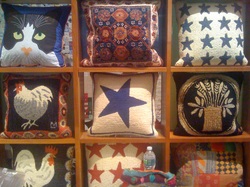 Saturday, November 5, 2011
I continued to investigate templates and plug-ins today. I also spent some time looking at gmail apps. Gmail apps are free to organizations with ten or fewer employees. The museum just barely meets that criteria. The advantage of google apps is access to google docs, a calendar, etc. which can be stored on line in the "google cloud." Then they are accessible from anywhere. That is convenient and easy. The other neat thing about google apps is that you can share your documents and calendar with other people. So, the museum could potentially have an on-line calendar that everyone has access to and can update when a new event comes up. I talked to Joan, the office manager about this possibility. She said it is something they have talked about doing before, but it just has not happened. Now that their email host will be changing, it might be the perfect time to take the leap.
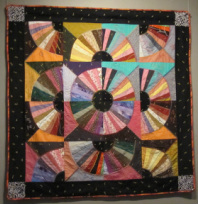 Friday, November 4, 2011
Today I continued to do preliminary work on the web site. The primary thing at this point is deciding the template or theme and whether we will use a splash page or not. A splash page is basically a front page on a website. Sometimes it's called a landing page. There is no navigation on that page, and you have to "click to enter." We have been looking at the websites of other museums. One of the things we have noticed is that many of them have a large image on the home page, and not much else. The current NEQM site is busy and as Connie says, it looks like a bulletin board. It has everything but the kitchen sink on it. Connie wants a home page that is smooth and focused. I agree with her.
If we don't use a splash page, we are going to use a plug-in on the home page. The plug-in will replace the header image and will be a slide show of some sort. We will also be using several different styles of pages. The overall look of them will be compatible with colors, fonts, etc. But they will have some variation such as the size of the header image -- it may be tall, short, medium, on non-existent.
So I pretty much spent the day checking out the options for plug-ins and templates. I identified the ones that I thought would work and started saving images, collecting themes and image sizes. I am also beginning to explore other options for email providers. I need to check with the domain host to see what their provisions are for email.
 Thursday, November 3, 2011 Today was spent finalizing my proposal for the NEQM web site. I have a semi-formal proposal that states the benefits of going to the new software. I included the benefits of using Weebly, such as automatic mobile sites (phones, ipads, etc.), ease of use, local backup capability, templates, HTML editing capability, multiple editor capability, and other features. Web development has come so far since I first learned HTML and Dreamweaver five years ago. In my proposal, I also provided financial details and a comparison to their existing host. Using weebly will cut their hosting costs by two-thirds. Since they have now made the decision not to do e-commerce, the monthly fee for merchant services will go away too. Earlier this week, I sent Maureen and Polly "permissions" to edit the NEQM test weebly site that I set up. I was eager to get some feedback from them. Maureen spent some time last night playing with it and loved it. She added content to pages including text and images. She said she learned how to use these features in about 20 minutes. How could it get any better than that? I went over my proposal with Maureen and we had a great discussion about what the possibilities could be. I think Weebly will offer her the ease of use she wants and the flexibility she needs to keep the site fresh. I am also confident that Weebly will continue to develop functionality. Through this process, I have a lot of research on Weebly. They are amazing. Long story short, it's a start-up that began with an assignment at Penn State University. The three developers submitted an application to Y-Combinator, and were selected to come to the Silicon Valley and work among the best. They were literally down the street from Google, Yahoo, and others. When Y-Combinator invited them to present their concept to potential investors, someone came forward with a buy-our offer which they declined. However, Weeby also found investors who were willing to fund them. People like Paul Buccheit, who developed gmail and later sold it to Google, were among the believers. So, they were off and running. They turned a profit in less than a year. Today Weebly is supporting 8 million users, continuing to develop new functions, and helping to make the world of website development accessible to average folks. They have been written about in the Wall Street Journal; Newsweek wrote about them in their 2007 article "Meet the Next Billionaires;" they were named in Time Magazines' 2007 50 Best Websites, and well, shall I go on? When some one at the museum voiced concerns about whether Weebly will continue to be a viable business, my immediate thought was, "when someone like Google offers to buy them, will they take the money and run, or will they keep their independence and go it alone?" I have read reviews where they are favorably compared with Wordpress and Tumbler. Weebly is only six years old. After I spent most of the day orienting Maureen to Weebly and the third party enhancements that were available, she agreed it was the best approach to take for the NEQM future website needs. We met with NEQM Director Connie Barlow and she agreed with our recommendation. This will result is moving from our existing web host to Weebly as a web host. Since our existing host also manages our email, we will have to decide who we want to use for email going forward. We agreed to make the switch on January 1. That gives NEQM plenty of time to load content, and to feature the next Exhibition which will open in mid-January. It's a GO!
 Wednesday, November 2, 2011 This morning the accession committee met to make decisions about whether to accept about 30 quilts that have been offered to the museum. It was interesting to see this process and the various considerations weighed in making decisions about each quilt. A few quilts received an immediate YES or NO! The committee is comprised of several people who are not on the museum staff. Some are appraisers, some are quilt enthusiasts. Also in on the fun were Laura Lane, collections manager, Pam Weeks, curator, and Connie Barlow, museum director. Although I think technically, the museum staff does not vote on which quilts to accept. The prize quilt of the day was a Baltimore Album reproduction of a quilt in the Abby Aldridge Rockefeller Folk Art Museum at Colonial Williamsburg. It was offerred by Marjorie Lydecker who spearheaded the effort by her Circle of Friends quilting group. The label reads, "Cape Cod Chapter of the Good Ladies of Baltimore of the State of Massachusetts." Finished in 1998, it is a masterpiece! As each quilt was unveiled and discussed, the following considerations were discussed: - Does the NEQM currently have a quilt in their collection representative of the quilt being considered? For example, a nice crazy quilt was reviewed. It was not accepted because a few of the fabrics were in bad condition; more importantly, the museum has 28 crazy quilts already. Some of the crazy quilts need to be de-accessioned.
- What is the condition of the quilt? The NEQM has no funds for conservation, so if the quilt is fragile, it may not be accepted simply because the museum can't properly care for it.
- What is the quality of the workmanship: piecing, applique work, quilt stitching?
- Does the NEQM need a quilt of this particular era, or pattern?
- Are the fabrics important and representative of a particular era?
- Is the quilt a good teaching piece?
- Does the quilt have unique qualities that will enhance the NEQM's collection?
- Does the quilt have provenance? Is there a story behind the quilt?
- Does the quilt have historical significance?
- The NEQM has storage issues. Every quilt we accept has to have a place to live when it's not on exhibit.
The committee was able to come to a consensus on all of the quilts. In the end, about ten of the 30 or so quilts were accessioned. Some of the quilts were given to the NEQM unconditionally which means if they are not accessioned, they can be sold with the proceeds going to the museum. I have not read the accession policy, but Laura told me where to find it and I will track it down.
 This afternoon, Pam and I had an appointment with Stephanie Hatch, a knowledgeable quilt collection and supporter of the museum. Stephanie has four quilts that she has agreed to lend to the museum for the upcoming exhibit, Campaigns and Commemoratives, Quilts for Presidents. What an interesting experience it was to see part of Stephanie's collection. She allowed us to photograph and measure the quilts. She also told some of the history of the fabrics and handkerchiefs used in the quilts. She also has quite a collection of campaign handkerchiefs and various historic fabrics. Stephanie is very generous to share her treasures with the NEQM and our visitors! It was fun driving to her house. She lives in Boxford which is almost as far as Ipswich. So, once again, I got to drive "over the river and through the woods," past the great pond, and through the beautiful fall foliage. I'm so lucky to be here!
 Ohio Quilt, 1855, The Shelburne Collection Tuesday, November 1, 2011
While I was in Vermont, I got an email from Polly, a volunteer who does a lot of the web site work under Maureen Smith's direction. Polly has a background in programming and is more computer savvy than most. Last week, when I began familiarizing myself with Joomla! and considering it for our new site development, I let both Polly and Maureen know so they could take a look too. Polly's email said she thought Joomla! was more software than they could handle. She had read some reviews, and really had not worked with the program. I sent her some links to see tutorials, etc. I personally don't think Joomla! is extremely difficult, nothing like Dreamweaver, that's for sure. However, to build a site from scratch from Joomla! you have to understand the architecture of the software. That is a little complicated, but not impossible. I think once I had the site constructed, Polly and Maureen could adapt to it.
However, because Polly voiced concern, I began looking at even simpler software. The trade off is less flexibility. However, ease of use is their #1 priority. They have felt so strapped down with Dreamweaver ever since they began using it. If they are going to leave that behind, they want software that is very easy. I get that. I have found the software for this blog very easy to work with. It's very intuitive and there are tutorials available. Weebly is a fairly new company and are rapidly building a following. They are also listening to their users and adding more and more functionality. The price is right too. But, my concern was whether it had the building blocks to construct a professional looking web site. So, I began to look at weebly more closely.
I spent many hours while I was in Vermont and after I got back home on Sunday night and Monday looking into weebly. By Monday, I was convinced it was a good possibility. I also began finding other themes on the web that worked with weebly. We want a front page that has some life to it, a slide show, or something more engaging than the current site. Weebly can accommodate that. I am also looking at other museum sites to see what they are doing. The Met, just brought up a new site at the end of August, so that's a good up-to-date site to look at. The Guggenheim, Winterthur, and the Peabody Essex are are worth taking a look at. Not only is their style helpful, but also how they have organized their site within the navigation. This is a good time for the NEQM to revisit how its pages are organized and see if they want to do it differently.
This afternoon I spent a little time with Connie and showed her some of the functionality we would have with weebly. Her criteria for the new site is that it have an up-to-date "look" and have some movement on the home page at least. In the weeks past, we have spent a little time looking at other museum sites, and that is what we are seeing a lot of. I showed her a neat slide program that can be put on weebly and she liked it a lot. It's a little different than the norm, and I consider it "artsy" as well. It will allow them to change their home page easily and without technical help. They can use it to highlight different quilts in the collection, or events at the museum, or something else.
To add this particular slide program to the site, it would have to be purchased from a 3rd party along with a template it resides in. As cost is a critical consideration in this decision, I also presented to Connie the financial ramifications of making these changes. Long story short, they will end up spending substantially less money on their site hosting if they go this direction, which leaves some funds to purchase a theme/template and slide show. I think they will be very happy with this and it is certainly cost effective. I think as time goes along, weebly will continue to add more and more function. The down side to going to weebly is that they will have to host the site in order for us to continue to easily update it as the NEQM would need to do. However, they do allow users to export sites built on weebly so we aren't necessarily required to host there; it would just make it easier and less expensive. Connie agreed to a budget for the new site development that was very reasonable for the museum and I think will more than accommodate the purchases that will be necessary.
Connie and I agreed that we would meet with Maureen and Polly later this week. I will make a presentation to them along with my recommendation. Then Connie and Maureen will make the final decision.
This is your new blog post. Click here and start typing, or drag in elements from the top bar.
Sunday, October 30, 2011Although I'm sure this image is hard to see, I had to post it because it's the map of the Shelburne Museum "campus." I knew it was an outdoor museum but nothing could have prepared me for this very special place. I was so determined to get here today that I left the Haitian PeaceQuilt opening early yesterday, and ran the slight risk that I would run into inclement weather. Why? Today is the last day of Shelburne's season. They close at 5:00 today until next spring. It was do or die so I did! And it was well worth it! For those who have been to the Shelburne, no explanation is necessary; for those who have not been, there are no words to describe. It is just incredible. My pictures from this jaunt to Vermont are here.  My first destination was the "Infashion: High Style, 1690-2011" exhibit at the Webb Gallery. The first garment I saw was a gown by contemporary designer Christian Siriano. It was extraordinary, featuring layers of delicate tulle that was all hand dyed and hand sewn in layers to create a gradient effect. It was the dress in real life shown on the banner on the left which is posted in front of the gallery. Well! That was just the beginning. I was treated to a "run way" show of haute couture gowns from the mid-late 19th Century to today. Some Charles Worth and Emile Pingat gowns were there alongside those by Bill Blass, Oscar de la Renta, Carolina Herrera, and others. They were all elegant, embellished with beautiful sequins and embroidery. A number of dresses were grouped together as "garden party" attire.
 The "Complete the Look" exhibit was of eight vintage bodices from Shelburne's collection paired with skirts designed by FIT students. It was old meets new, and very well done! Another exhibit featured a collection, of 1950's dresses worn by the museum's founder, Electra Havermeyer Webb. A poodle skirt embellished with appliqued motifs telling her life's story was my favorite. Others included the gown she wore when celebrating her 50th wedding anniversary and the dress she wore to her granddaughter's debutante ball. Lastly, there was a collection, "Head to Toe, of hats, bonnets, shoes, handbags and fans from the 18th and 19th centuries. Part of this collection was haute couture outerwear. Some of these capes by Emile Pingat were elegant -- so delicate and beautiful.
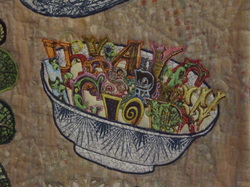 Detail of Alphabet Soup, Joan Lintault The Hat and Fragrance Textile Gallery called my name next. About 60 or so quilts from the Shelburne's collection were on exhibit. Also, "Passion for Quilts: Joan Lintault Collects" was on exhibit. It included three quilts she designed and made. They are incredibly detailed and simply beautiful works of art. I wish there were more than three. I think I could have stood there for an hour fixated on Lintault's work alone. But, since she had donated a number of quilts from her personal collection, I still had more to see. I was overwhelmed! The amount of exhibition space available in just this one gallery is amazing. Although the NEQM houses quilts exclusively, the number of quilts on exhibit at the Shelburne far exceeds what the NEQM has space for.
 Jacquard Loom After I left the quilt exhibits, I wasn't necessarily on a mission to go any special place. I was just strolling around and saw a sign that said "Weaving Shop." Well, that sounded pretty good, so I went on in. What the HELL! There was a real Jacquard Loom in there! No kidding, I almost lost my mind. Although the loom is operated most days, today it was not. I had a chance to speak with a woman who knew all about it and she showed me the "cards" and tried to explain how it worked. I understand the card system, but don't really get how the punched holes work to determine the yarn placement and ultimately create the pattern. This loom has a pattern made with 700 cards. I was able to purchase a small piece of cloth that was made on the loom. It's not very big, only the size of an over-sized place mat, but I don't care!
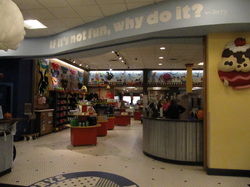 I didn't want to leave the Sheburne, but I wanted to get close to home before dark. The nor'easter that hit while I was gone dumped 8" of snow on Lowell. I didn't know what I might find, although I was pretty sure the roads would be dry because the day today was warm and sunny. In fact, for a day that could have been very snowy and cold, I had a beautiful warm day at the Shelburne. It was about 50 degrees and sunny!
On my way home, I drove right by a Ben & Jerry factory. I did the only thing any ice cream lover could have possibly done: I stopped and took a tour, which of course included the ice cream tasting room. I saw the six stainless steel drums that hold 50,000 gallons of ice cream mix. All that ice cream! Really! A sight to behold!
I drove home to Lowell seeing more and more snow as I traveled south. After I got off the highway, I encountered many stoplights that weren't working. That was really something because I'm not familiar enough with this area to even know where they are and it was very dark. There were also many tree limbs littering the sides of the roads. Still more tree branches were hanging so low that it looked like they wouldn't clear my car. It would have been very scary if it hadn't been a Sunday night when the traffic was light. When I arrived home, Marriette and Jim told me most of Lowell was out of power. Thankfully, they only lost electricity for a short time.
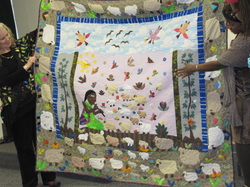 Nadege describes imagery she used in her Biblical art quilt Saturday, October 29, 2011Today was the official opening for our new exhibition, Patience to Raise the Sun: Art Quilts from Haiti & Their Power to Change Women's Lives. We all arrived early this morning to prepare for the program and reception. At 10:30 docent training was held by the curator, Pam Weeks. She had previously sent out the docent guide and so there was some discussion about what other information the docents would like to have. Later in the morning, the VIPs from Haiti PeaceQuilts began arriving. They included founder Jeanne Staples, quilting coordinator Maureen Matthews McClintok, Haitian quilt artist Nadege Florian, and Bennington Museum Curator of Collections Jaime Franklin. We greeted them and an informal gallery tour and light lunch followed.
 Nadege sewing a missing button on the "Piti Piti" quilt. When we received the quilts for the exhibit and did the condition reports on them, I noticed two buttons were missing from one quilt. Jaime found one of the missing buttons in his gallery and we rounded up another. Nadege took a few minutes to do the repair, sewing on the missing buttons. She also repaired a treadle sewing machine in the museum by replacing a worn out belt with a new one made of braided fabric. Quite resourceful!
After lunch the presentation began. NEQM Director Connie Barlow and Susan Wornick, a local celebrity and anchorwoman, gave opening remarks. Jeanne told us the story of how she came to form PeaceQuilts and the purpose behind the organization. She was joined by Maureen and Nadege who talked about the formation of the cooperatives, how quilting skills are taught to the Haitian women, and the impact they have had on the lives of so many. Nadege, who used a translator, unveiled her latest creation, an art quilt with a Biblical theme. The presentation was followed by a reception. Haitian music, story telling, and quilting lasted the rest of the afternoon. This event was very well attended and a lot of fun!
I had plans this afternoon to leave for Vermont after the opening. BUT, there is a big storm on the way, a nor'easter they say. To avoid getting caught in a snowstorm, I left a little early, so I missed out on the story telling and music. When I left, it began raining, then the little slushy stuff we all hate to see started hitting my windshield. I was really nervous even though all the weather maps showed Vermont was out of the storm's path. We are already hearing reports of the huge snowfalls in Pennsylvania and other states south of us. By the time I reached the New Hampshire border, the skies were gray, but the rain and slush had stopped. I arrived at my destination, a little inn in Stowe, Vermont a few hours later. The inn keeper said he thought they may get a "dusting" that night, which meant an inch or two of snow. He was right. Below is a picture I took the following morning!
Tuesday, October 25, 2011
It's back to work at the museum today! Play time is over. There is a web site to build! I have spend this week, Tuesday through Friday in meetings discussing the new NEQM web site and researching technology for building it. I seriously considered Drupal because it offers so much flexibility and that type of modular approach is the wave of the future. But Drupal is pretty intense and the learning curve is pretty big. I would need someone to help me, and/or some training materials that would have to be purchased. The museum has no budget for that.
I looked at some other web builders, which quite frankly are everywhere -- all over the net. Some of them look pretty good, but they all seem to require that you host with the company offering the web builder. I don't think it's wise to get locked into a hosting company. Things change, and we can't predict what the museum's web needs will be in two or three years. I don't want them to be in a position where they are forced into making changes they may not want to make.
 Finally, I think I have found something that will work well. Joomla! is similar to Drupal, but not as high level. It requires no coding knowledge, although you can alter the code for certain effects if you know how. The web has an abundance of teaching tools and videos that are all free. I have a host that caters to Joomla! and will give support for Joomla! sites in addition to the support they offer for hosting. I have watched some videos and started building a test site to see how the system works. I like the idea of being able to add extensions and endless functionality. I think it will help the museum keep their site fresh as time goes along.
I am also helping the museum librarian, Martha Supnik, find software that will allow their book database to be searched on-line from the web site. This library has many thousands of books. They lend to museum members. They also have a perpetual yard sale. Any books donated to the library that are duplicates are for sale for $5 or $10. So far, we are still in the software learn and search mode. Martha has found a library package she thinks she might like, but isn't sure. She would like to test it out before committing. I found that the Guggenheim Museum uses both Joomla! and the library software she likes. Maybe that will help her decide. I was really hoping she would like a Joomla! extension that was designed for a library search. Unfortunately, she really didn't care for it, although I thought it had all the function she needs.
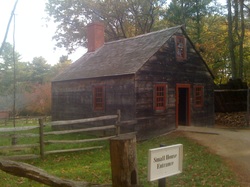 Monday, October 24, 2011
Old Sturbridge Village is a living history museum that portrays life in New England during the 1830s. All the structures are authentic, but have been moved to the site to emulate a village from the time period. There are many businesses including a tavern, a tin shop, a law office, a printing office, etc. We especially enjoyed the Fenno House which depicted the life of a widow and her daughter who engaged in spinning and weaving. Raw cotton, wool, flax, and silk fibers were on display in the house, and wool carding brushes were available so visitors could try their hand at it. The widow was there spinning with her loom nearby. Upstairs were two bed chambers with quilts, a sewing table, and some furnishings and costumes from the period. There were several exhibits housed in period buildings. The ones we really enjoyed were the glass exhibit and the textiles exhibit (of course!). The textile exhibit had examples of hand looms, and power looms. The museum put a great emphasis on how the spinning and weaving technology that developed during the late 17th and early 18th centuries impacted the lifestyles of New Englanders. Less and less spinning and weaving was occurring in homes. Technology to improve farming techniques decreased the amount of time required to raise crops. Transportation became faster, and more available. Fewer farms gave way to urban life where factory and trade work was available. By 1840, more than 670 cotton factories were operating in New England. Fewer and fewer people were purchasing cloth rather than weaving it in their homes. The economy was transformed and the textile industry became the most important industry in New England for the next 150 years. The textile exhibit had examples of hand and power looms, exhibits that featured recipes for dying cloth, and samples of drafts (patterns) and weaving patterns that survived from the 19th Century. These patterns were for overshot bed coverlets and diaper cloth for tablecloths and dishtowels. The patterns had all the information to set up the loom and how to weave the pattern. These patterns were recorded by a mother and daughter from Dartmouth, Massachusetts.
We toured the Salem Towne House, built in 1796 and moved to Old Sturbridge Village in 1952. I was surprised by how nice it was. There was lots and lots of wallpaper! There was a carpet in the front parlor. The pattern was a repeated block and looked like quilt squares to me. In the center hall and dining room there was canvas on the floor that had been painted to look like carpet. Interesting to see that. The guide said the home would have belonged to an upper middle class family. It was very, very nice. There were quilts on the beds up stairs, but we couldn't get close enough to see them very well.
 Sunday, October 23, 2011This morning we left early, our sites set on New York once again. So off we went, this time driving into the city from the south. Oh what a view! Since it was Sunday, the traffic was light and we even found parking -- and not illegal parking like last week :) We went to the 9/11 Memorial first. We weren't able to get tickets ahead of time, and those for the day were already gone, so we didn't go on a tour. We had to be satisfied with what we could see. There is covered fencing up all around area, and you couldn't see in at all. This was much different than four years ago when I was visiting New York with Mozelle. At that time, you could look through the fence and see everything that was going on. A woman at the memorial office suggested we go to the Winter Garden at the World Financial Center. We did that and found quite a view. Some of the towers that are being rebuilt are well underway and that progress was good to see. The new Tower One, nicknamed The Freedom Tower will be 1776 feet tall when it's finished. We then found our way to 8th and 66th street, just a block from Central Park. During lunch at a sidewalk cafe in Lincoln Square we had a great time people watching. Since it was Sunday late morning, many families were coming/going to church. In their fancy dresses, all the little girls were adorable; then there were the toddlers who wailed because they wanted to be carried, or the reverse, they wanted to walk; the most impressive of all was the woman in the five inch leopard-print heels had to take the cake. How could she walk anywhere in those? OUCH! Right next door was the American Folk Art Museum. They had a great quilt exhibition up called Super Stars: Quilts from the American Folk Art Museum. Also, the 9/11 National Tribute Quilt was on display. Tomorrow is Monday and the NEQM is closed. So, what's on the agenda for Pam and I? Well, since we have to go by Old Sturbridge Village we will stop there tonight and visit there in the morning!
 Saturday, October 22, 2011
On the way to Winterthur yesterday and today we drove through a beautiful covered bridge. The days here have been sunshine and crisp, just perfect fall weather. Today's lectures were equally as interesting as those from yesterday, topped off by a fascinating presentation by Dr. Lynn Hulse former archivist at the Royal School of Needlework. In the afternoon we attended two workshops: The first was an opportunity to look at many of the rare books, patterns, scrapbooks, and other ephemera in the Winterthur libraries. I really enjoyed looking at these! We also went on a tour of the needlework in the Winterthur collection located on the fifth and sixth floors of the mansion. What lovely samplers and quilts we saw! Sadly, it was the end of this wonderful adventure.
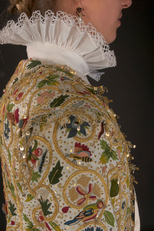 Friday, October 21, 2011 Today we arrived at Winterthur, the home Henry Du Pont lived in and later made into a museum. The conference was held at their visitor center and was everything I hoped it would be and more! The first lecture was given by Tricia Wilson who was a key person in the Plimoth Jacket Project. She explained how the project was conceived, planned, and carried out. The project resulted in a reproduction of a 17th Century embroidered jacket. All work was carried out by hand just as it was when the original was made. Jill Hall, co-manager of the project gave a fascinating talk about clothing in the 17th Century and the use of decorative gold thread and spangles. She said that at that time there was no currency and so clothing was often like a "bank" to the owner. These gold laden clothes could be pawned for their gold. When they were no longer wanted, there was an active resale market where clothes were often burned in order to recoup the gold. Other lectures focused on needlework samplers and the training young girls received in stitching.
 1787 Rachel Mackey Quilt embroidered medallion 1787 Rachel Mackey Quilt embroidered medallion After eating a scrumptious lunch, Pam and I took a tour of the grounds which included a 60 acre garden planned by Mr. Du Pont as well as the Enchanted Woods, a garden for children. Afterward, we went to the house museum and took a tour of the third floor. We spent the remainder of the afternoon enjoying the exhibitions. The With Cunning Needle: Four Centuries of Embroidery exhibition of course related to the conference and is where the Plimoth Jacket was displayed. In one of the galleries we saw a beautiful 18th Century quilt with an embroidered center medallion. It is an extraordinary piece that is in very good condition. It was exciting to see this as one of my particular interests is quilts with embroidery. I wonder if some of the motifs seen in samplers and other embroidered pieces can be found in embroidered quilts of the same time?
 Times Square New York City Thursday, October 20, 2011 New York City is always a hustle bustle place and today was no different. We drove into the city and luckily finally found a place to park that wasn't too far from the Metropolitan Museum of Art, our first destination. It was a beautiful day and we saw everything from the Naked Cowboy singing in Times Square to a police officer on horseback to various musicians playing on the street corners. In fact, there was a group that was singing in front of the Met.
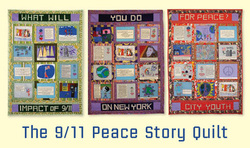 Faith Ringgold's 9/11 Peace Story Quilt was the first place we went. This "story" quilt was three panels hung side by side. It was designed in collaboration with New York City students. Reactions to the events of 9/11 are recorded in the words and images from children ages eight through nineteen. The overall message is one of hope and peace with a united world. The exhibition Arts of Korea/Patchwork Textiles was our next destination. These pieces, some contemporary, were beautiful and fascinating. The stitches were tiny, tiny, and the motifs beautifully executed. Although the name of the exhibition leads you to believe the objects will all be Korean, it also includes textiles from China, and Peru. An Amish quilt from the United States was included to illustrate its similarity to some of the Korean pieces. The interesting question is: how did these both develop in cultures that were not connected? Unfortunately for us, we didn't have nearly enough time to spend at the Met. However, just being in the building is exciting and intriguing. It is so grand, so busy, so varied in its many offerings. Everywhere you turn is something else more fascinating than the last. When we walked from the Ringgold exhibit to the Korean textile exhibit, we literally went from one end of the museum to the other. In between we went through the ancient near eastern art, the Asian, (last time I was at the Met I hung out there LOVE IT!), and Egyptian galleries. It was absolute torture to have only a few short moments here and there to stop and enjoy these objects. It was all about the parking! We had a parking place on the street about six blocks away. God forbid, we didn't want a ticket! We could have parked in the Met's garage, but thought $15 per hour was outrageous. However, we saw other garages later in the day with rates up to $30 - yes, that is for each and every hour that they mind your auto! That makes my head spin!
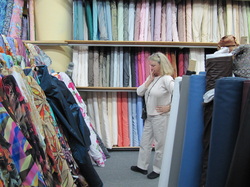 Next stop: the garment district. Pam is participating in a civil war reenactment and must find some silk to make a period dress. So she simply had to drag me down to 39th street! What a terrible terrible fate :) Fortunately the parking was not nearly so difficult there. We found lots of parking places in a commercial zone, so we simply parked illegally and just kept an eye on the car in between shops! We had a grand time and Pam found her silk. I was drooling the entire time, of course. I haven't sewn clothes in many, many years, but these glorious fabrics are wonderful inspiration to begin again! Go see a few photos of these fabrics, and lovely trims -- yes, we went to a shop that carried only trims, buttons, and other specialty notions. !!!!
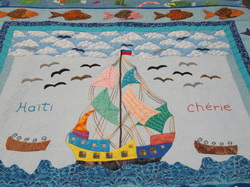 Haiti Cherie Art Quilt Wednesday, October 19, 2011
This morning was spent double checking the quilts packed to be returned to their owners and moving the boxes and other quilts packed in bags and pillowcases downstairs to the shop vault for safe keeping. That sounds pretty simple, but what a haul! Our shop vault does not have much extra space, and a few of these boxes are really LARGE! I am talking about the quilts that were loaned to us by museums. The quilts were packed in archival boxes and then in shipping boxes. They weren't very heavy, but very awkward indeed.
Then I spent some time with Maureen Smith, the public relations director for NEQM. I introduced her to Web building technology that I think is the best way to go for the time being for their web site. There are many different "brands" of Web building technology, but in the end most of it is just drag and drop to create a site with text, images, and slide shows. It would be really nice if they could have an entire site rebuild by a professional Web designer assisted by a graphic designer. That isn't going to happen in the immediate future, but I have made the suggestion. Perhaps grant money might be the way to get that done. I have also suggested they forge a partnership with the University of Massachusetts in Lowell and see if they can get a couple of interns that specialize in software development/Web design and graphics. That would be very helpful.
This afternoon the curator, Paw Weeks, and I left for our trip to Winterthur, Delaware, where we are going to a needlework conference. Our goal was to drive a few hours out of town towards New York so we could get a jump on our driving. Tomorrow we are headed to New York for the day!
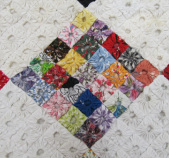 Yo Yo Quilt from the Maine Exhibit Today was spent finishing up condition reports and packing the remaining quilts from the Maine exhibition. The good news is that it's all done. It was nice today to have a museum volunteer to help me with the turning and folding. Thank you Betty! It takes a lot longer to do it by yourself when you are working with quilts that are very fragile like the ones today. We did have one crazy quilt to send back that was just BEAUtiful! It was in almost perfect condition, which doesn't often happen with crazy quilts. They usually have silks in them that have deteriorated with age. There is one quilt we need to track down the box for and one more little doll quilt that I think was sent with someone else's quilt. I need to find out who. Then the paperwork needs to be generated and the boxes shipped. Almost there!
|














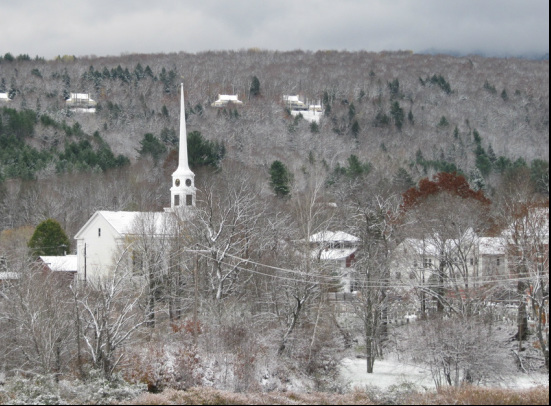


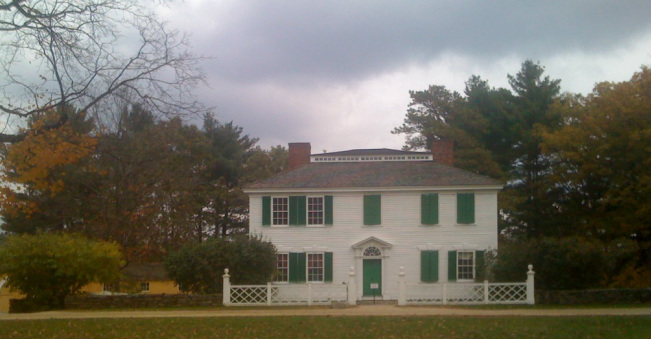









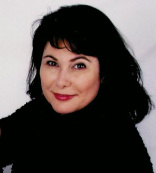
 RSS Feed
RSS Feed